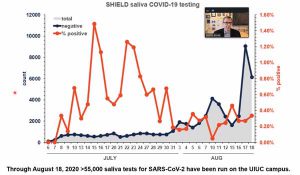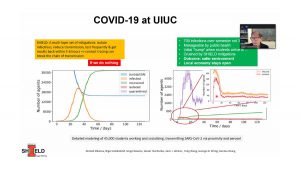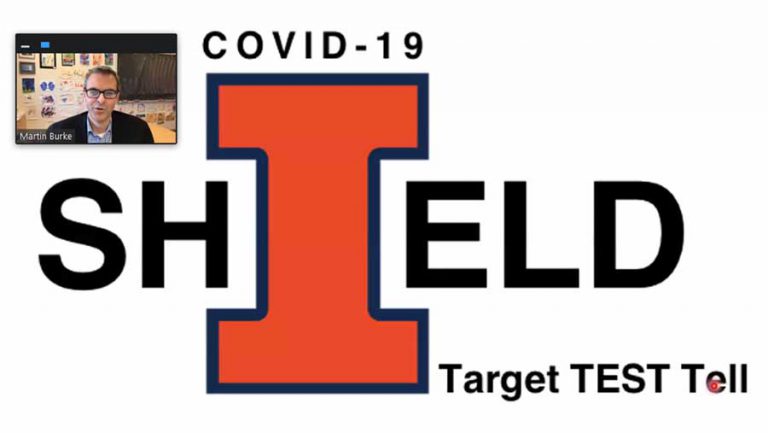EDITOR’S NOTE, Sept. 29: This story is no longer up-to-date, as University of Illinois officials claimed the campus’ saliva-based test had received FDA emergency use authorization on Aug. 19, but an FDA spokesperson tells Illinois Newsroom the test has never operated under an EUA. For more information on the newly learned details, click here.
URBANA – With an estimated 45,000 students returning to east-central Illinois to start the fall semester at the University of Illinois at Urbana-Champaign, the number of saliva-based COVID-19 tests collected and analyzed on campus has jumped to about 10,000 a day.

Out of more than 30,000 tests performed this week, about 100 positive cases have been identified so far among students and employees, said U of I chemist Martin Burke, who joined campus officials for a press briefing with reporters on Friday.
Because test results are received within a day, Burke said those who are positive are quickly identified and isolated, which breaks the “chain of transmission.”
Campus officials said they’re encouraged by the low positivity rate, which has hovered below 0.5% this week.
U of I professor Nigel Goldenfeld, whose modeling has helped inform the university’s reopening plans, said the initial bump in cases is expected.
“What we estimate is that… of those 45,000 (returning students), about 198 to 200, plus or minus, will be positive, not because they got the infection here in Urbana-Champaign, but because they got it wherever they came from,” Goldenfeld said.
Without rapid testing and isolation, Goldenfeld said COVID-19 would spread to 20,000 students within about a month. But with mandatory twice-a-week testing and other mitigation efforts, he said he expects the total number of cases this semester will be about 500, in addition to the 200 people who arrived already infected.

Goldenfeld said the models predicting a total of 700 positive COVID-19 cases this semester make “conservative worst-case assumptions” about student behavior as it pertains to party-going and large gatherings without masks.
The models predict that most community transmission will occur through exposure at restaurants, bars and parties, and in classrooms.

A public database will launch on Monday, with daily updates on the number of COVID-19 tests and cases, as well as the five-day average positivity rate and daily positivity rate, said Burke.
The specific locations on campus where outbreaks and clusters of COVID-19 are being detected will not be reported.
C-U Public Health District Administrator Julie Pryde said the location of outbreaks is only reported to the public when it’s necessary to do so to protect public health. She said that for instance, locations might be made public if contact tracers are unable to identify everyone who was exposed at a gathering where the virus is known to have spread.
Pryde said the U of I’s ability to do rapid testing enables her agency’s contact tracers to quickly isolate or quarantine those who are sick or have been exposed.
Those who are exposed must remain in quarantine for 14 days, and there’s no option to “test out of quarantine,” Pryde said.
Goldenfeld said the “Smarter Illinois” app will complement C-U Public Health’s contact tracing efforts by notifying people who may have been exposed to someone who goes on to test positive for COVID-19.
He said the app is able to do so without tracking users’ locations.
The Urbana campus’ Vet Med labs, which have been equipped with RT-PCR machines and staffed to process the onslaught of COVID-19 tests samples coming in, now have the capacity to process up to 20,000 tests a day, Burke said.
And the saliva-based test, developed by Burke and his U of I colleagues, received emergency use authorization from the FDA this week.
Tests processed on the U of I Urbana campus now account for about 1 to 2% of the total daily COVID-19 tests conducted in the nation, and about a fifth of all tests conducted in the state.
Pryde said the U of I’s COVID-19 testing program a “game-changer” that “wildly exceeded” her expectations.
She said she gets calls from colleagues across the nation who are fascinated by what the campus is doing and believe this kind of testing strategy is needed to help reopen the entire country.
College campus reopening plans vary widely across the U.S. — with some schools planning to reopen and limit testing to those who show symptoms of COVID-19.
In a preliminary analysis of 500 college reopening plans, researchers from the California Institute of Technology finds that about one in four plan to test students upon arrival to campus, and one in five plan to test “regularly to some extent.”
Christine Herman is a reporter for Illinois Newsroom. Follow her on Twitter: @CTHerman

